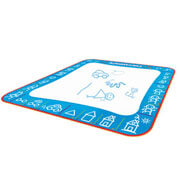My son is non-verbal autistic, so we are working on letters and words many times a day in the hopes that one day it will just “click.” He’s made great strides, and we have a few toys to thank for that. Here are some favorites that have been useful in Brady’s various therapies as we work to build letter and word recognition and understanding.
AquaDoodle – This toy is great for practicing straight lines, letters, words, shapes, tracing and more. Brady loves drawing his lines and circles and then watching them disappear. The pen is a nice size and makes for an easy transition to markers and pencils. You can even try using stencils and rulers to aid in drawing the more difficult letters and shapes.
LeapFrog Fridge Phonics – This classic toy can help with letter recognition, and the phonics element of language learning. Scout sings a catchy tune to show you the different ways the letters sound. You can group the letters on the fridge to spell words, teach vowels and more. This is a great tool for kids learning the beginnings of word formation or even to recognize their name.
MagnaDoodle – Like the AquaDoodle, this toy lets children draw, erase and draw again. I love that the smaller travel sized ones are so portable. They are easy to take in the car or to include some learning if we are out at a restaurant. Some of the larger sized MagnaDoodle’s even have stencils and shapes included.
LeapFrog Scribble and Write – LeapFrog really knows how to integrate learning into fun and make learning fun. This toy lets kids trace the lights to learn their letters. Teaching pencil control/holding, letter recognition, the alphabet and letter sounds is both entertaining and engaging primarily because of the novelty of the lights and the activity of tracing. There are also games built in, and parents can connect this toy to the computer to see and track their child’s progress through the LeapFrog Learning Path online.
Baby Einstein Alphabooks Board Book Set – Colorful, bright and sturdy, each of these twenty-six board books features real-life photos and works of art depicting everyday objects. The books help in three ways that can make them an effective addition to your library. First to help kids learn to match letters to the words they spell. Second, they use both upper case and lowercase letters, which helps with recognition. Finally, and importantly, these books are sized perfectly for tiny hands, so they are easy to hold and use.
These are just a few examples of toys and books that can help teach your special needs child (or any child) about letters. All of them are, like many toys, most effective when a parent or therapist works with the child. At the same time, they are complete and well developed so that kids can benefit from solo time with them.
What are your favorite activities and toys for letter recognition?

